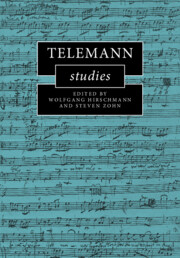Book contents
- Telemann Studies
- Cambridge Composer Studies
- Telemann Studies
- Copyright page
- Contents
- Figures
- Music Examples
- Tables
- Appendices
- Contributors
- Preface
- Abbreviations
- Part I Enlightenment Perspectives
- Part II Urban and Courtly Contexts
- 4 Telemann, Lüneburg, and Roger Brown
- 5 Hamburg Passion Music at Telemann’s Arrival
- 6 The Testament of Prince Johann Ernst of Saxe-Weimar
- Part III Nature (and) Theology in the Late Vocal Works
- Part IV Bach Family Connections
- Part V Cantata Cycles in Frankfurt, Hamburg, and Beyond
- Index of Telemann’s Works
- General Index
5 - Hamburg Passion Music at Telemann’s Arrival
from Part II - Urban and Courtly Contexts
Published online by Cambridge University Press: 14 July 2022
- Telemann Studies
- Cambridge Composer Studies
- Telemann Studies
- Copyright page
- Contents
- Figures
- Music Examples
- Tables
- Appendices
- Contributors
- Preface
- Abbreviations
- Part I Enlightenment Perspectives
- Part II Urban and Courtly Contexts
- 4 Telemann, Lüneburg, and Roger Brown
- 5 Hamburg Passion Music at Telemann’s Arrival
- 6 The Testament of Prince Johann Ernst of Saxe-Weimar
- Part III Nature (and) Theology in the Late Vocal Works
- Part IV Bach Family Connections
- Part V Cantata Cycles in Frankfurt, Hamburg, and Beyond
- Index of Telemann’s Works
- General Index
Summary
How did Telemann’s liturgical passions relate to the settings heard in Hamburg in the decades before his arrival? This is difficult to answer, because we have passion librettos from the tenure of Telemann’s predecessor as cantor Joachim Gerstenbüttel but not a note of music. For the parallel tradition at the religiously and politically independent Cathedral (Dom), a good sample of texts presented under five Domcantors survives but only one unrepresentative piece. The printed librettos document a nearly static passion tradition from the late seventeenth century through 1721, with few signs of the sort of modern poetry and music that Telemann would begin presenting the next year, despite a tendency for historians to search for developments toward the modern oratorio passion. Hamburg passions likely relied on works such as Johann Sebastiani’s St. Matthew setting published in 1672, and the librettos suggest that the annual revision of passions extended only to substitute texts for settings of chorales and simple solo arias. Scattered surviving materials allow the partial reconstruction of a passion credited to Diedrich Becker that was performed at the Hamburg Dom from 1678 until at least 1717. Thus Telemann’s passion settings represented something almost entirely new to the Hamburg liturgy after decades of stagnation.
- Type
- Chapter
- Information
- Telemann Studies , pp. 98 - 133Publisher: Cambridge University PressPrint publication year: 2022



